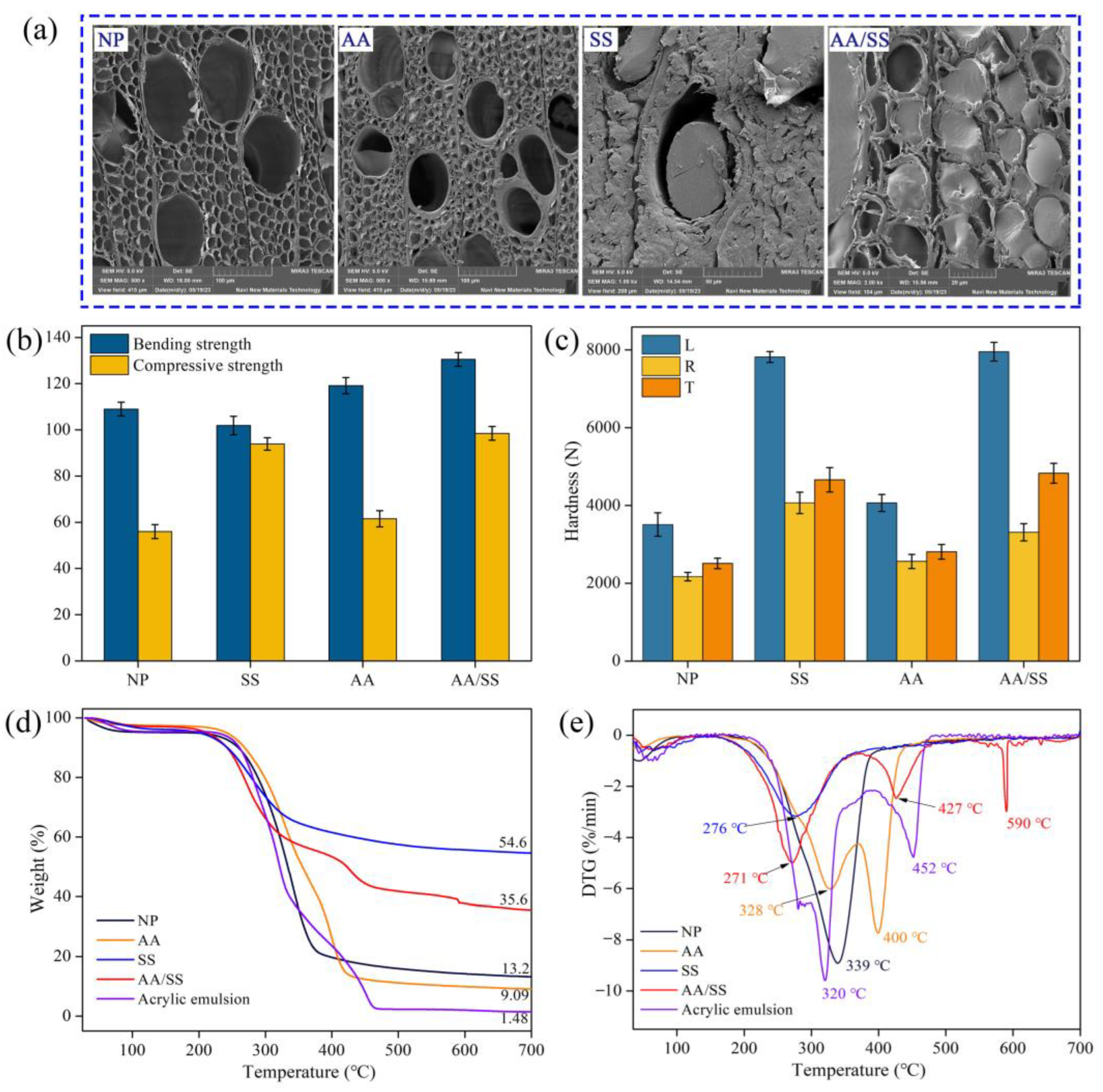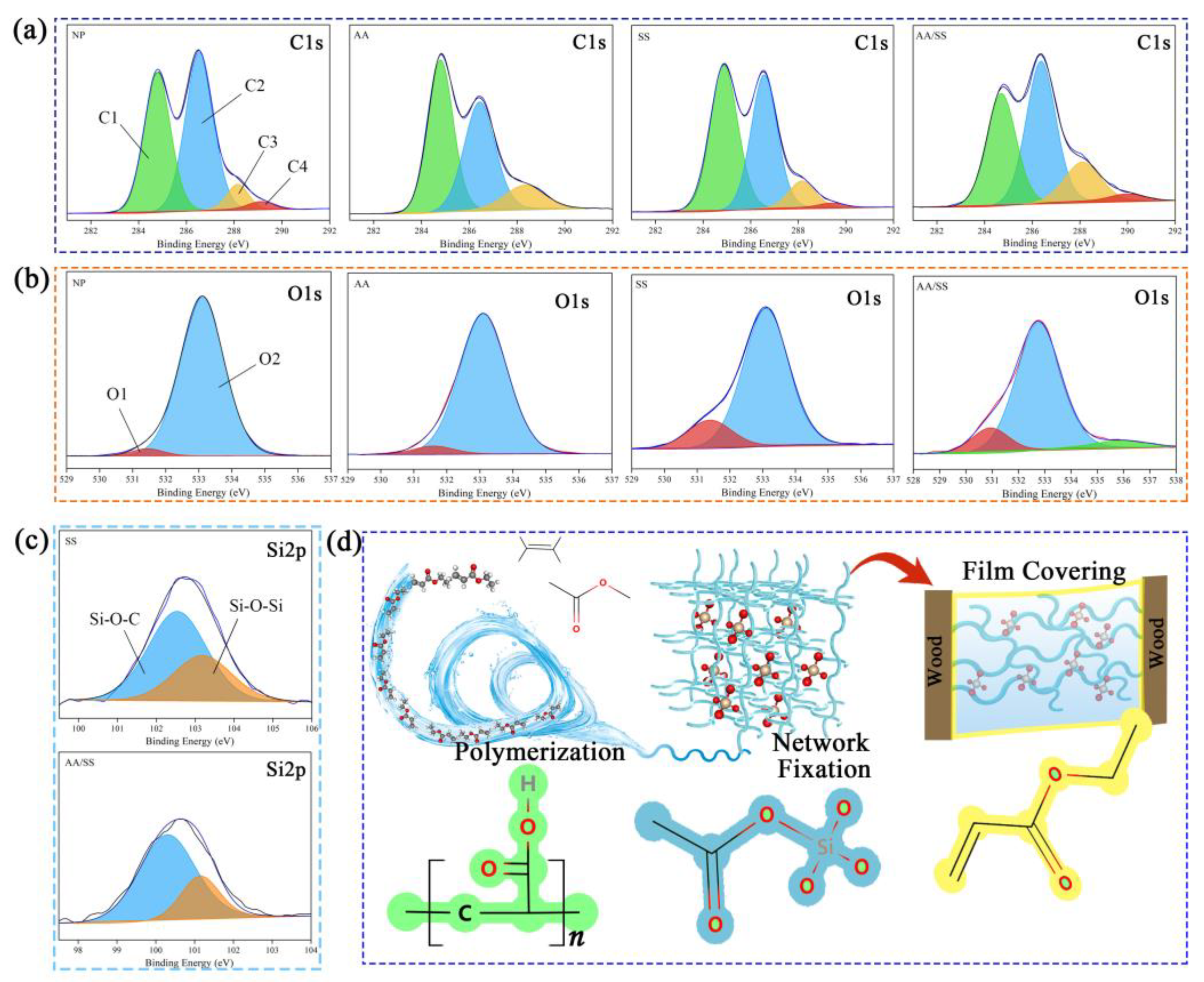Study on the Effect of Acrylic Acid Emulsion on the Properties of Poplar Wood Modified by Sodium Silicate Impregnation
Abstract
:1. Introduction
2. Materials and Methods
2.1. Materials
2.2. Preparation of Modified Poplar Wood
2.3. Characterization Test Methods
2.3.1. Hardness Test
2.3.2. Bending Strength and Compressive Strength Test
2.3.3. Water Absorption Test and Swelling Test
2.3.4. Fourier-Transform Infrared (FTIR) Spectroscopy
2.3.5. X-ray Diffraction (XRD)
2.3.6. Scanning Electron Microscopy (SEM)
2.3.7. Thermogravimetric Analysis (TGA)
2.3.8. Statistical Analysis
3. Results
3.1. Effect of Acrylic Emulsion on the Mechanical Properties and Thermal Stability of Sodium Silicate-Modified Poplar Wood
3.2. Effect of Acrylic Emulsion on Water Resistance
3.3. Influence of Acrylic Acid Emulsion on the Chemical Structure and Moisture Barrier Mechanism
4. Conclusions
Author Contributions
Funding
Data Availability Statement
Conflicts of Interest
References
- Moradpour, P.; Behnia, M.; Pirayesh, H.; Shirmohammadli, Y. The Effect of Resin Type and Strand Thickness on Applied Properties of Poplar Parallel Strand Lumber Made from Underutilized Species. Eur. J. Wood Wood Prod. 2019, 77, 811–819. [Google Scholar] [CrossRef]
- Niemczyk, M.; Przybysz, P.; Przybysz, K.; Karwański, M.; Kaliszewski, A.; Wojda, T.; Liesebach, M. Productivity, Growth Patterns, and Cellulosic Pulp Properties of Hybrid Aspen Clones. Forests 2019, 10, 450. [Google Scholar] [CrossRef] [Green Version]
- Yue, K.; Qian, J.; Wu, P.; Jiao, X.; Lu, D.; Song, X. Experimental Analysis of Thermally-Treated Chinese Poplar Wood with Focus on Structural Application. Ind. Crops Prod. 2023, 197, 116612. [Google Scholar] [CrossRef]
- Zhang, Y.; Guan, P.; Zuo, Y.; Li, P.; Bi, X.; Li, X. Preparation of Highly-Densified Modified Poplar Wood by Evacuating the Micro-Pores of Wood through a Gas Expansion Method. Ind. Crops Prod. 2023, 194, 116374. [Google Scholar] [CrossRef]
- Guan, P.; Li, P.; Wu, Y.; Li, X.; Yuan, G.; Zuo, Y. Comparative Study on the Properties of Inorganic Silicate and Organic Phenolic Prepolymer Modified Poplar Wood by Vacuum Cycle Pressurization. J. Renew. Mater. 2022, 10, 2451–2463. [Google Scholar] [CrossRef]
- Wu, S.S.; Tao, X.; Xu, W. Thermal Conductivity of Poplar Wood Veneer Impregnated with Graphene/Polyvinyl Alcohol. Forests 2021, 12, 777. [Google Scholar] [CrossRef]
- Kumar, S.P.; Takamori, S.; Araki, H.; Kuroda, S. Flame Retardancy of Clay–Sodium Silicate Composite Coatings on Wood for Construction Purposes. RSC Adv. 2015, 5, 34109–34116. [Google Scholar] [CrossRef]
- Garskaite, E.; Karlsson, O.; Stankeviciute, Z.; Kareiva, A.; Jones, D.; Sandberg, D. Surface Hardness and Flammability of Na2SiO3 and Nano-TiO2 Reinforced Wood Composites. RSC Adv. 2019, 9, 27973–27986. [Google Scholar] [CrossRef] [Green Version]
- Zhang, Y.; Bi, X.; Li, P.; Wu, Y.; Yuan, G.; Li, X.; Zuo, Y. Sodium Silicate/Magnesium Chloride Compound-Modified Chinese Fir Wood. Wood Sci. Technol. 2021, 55, 1781–1794. [Google Scholar] [CrossRef]
- Dong, X.; Zhuo, X.; Wei, J.; Zhang, G.; Li, Y. Wood-Based Nanocomposite Derived by in Situ Formation of Organic-Inorganic Hybrid Polymer within Wood via a Sol-Gel Method. ACS Appl. Mater. Interfaces 2017, 9, 9070–9078. [Google Scholar] [CrossRef]
- Yona, A.M.C.; Žigon, J.; Kamlo, A.N.; Pavlič, M.; Dahle, S.; Petrič, M. Preparation, Surface Characterization, and Water Resistance of Silicate and Sol-Silicate Inorganic–Organic Hybrid Dispersion Coatings for Wood. Materials 2021, 14, 3559. [Google Scholar] [CrossRef] [PubMed]
- Chen, H.; Lang, Q.; Bi, Z.; Miao, X.; Li, Y.; Pu, J. Impregnation of Poplar Wood (Populus euramericana) with Methylolurea and Sodium Silicate Sol and Induction of in-Situ Gel Polymerization by Heating. Holzforschung 2014, 68, 45–52. [Google Scholar] [CrossRef]
- Bi, X.; Zhang, Y.; Li, P.; Wu, Y.; Yuan, G.; Zuo, Y. Building Bridging Structures and Crystallization Reinforcement in Sodium Silicate-Modified Poplar by Dimethylol Dihydroxyethylene Urea. Wood Sci. Technol. 2022, 56, 1487–1508. [Google Scholar] [CrossRef]
- Liu, Q.; Du, H.; Lyu, W. Physical and Mechanical Properties of Poplar Wood Modified by Glucose-Urea-Melamine Resin/Sodium Silicate Compound. Forests 2021, 12, 127. [Google Scholar] [CrossRef]
- Gao, S.; Qi, J.; Jiang, S.; Wu, T.; Wang, W.; Cai, Y.; Ma, C.; Zhang, B.; Huang, J.; Yan, Y. Green Wood Adhesives from One-Pot Coacervation of Folic Acid and Branched Poly(Ethylene Imine). ACS Appl. Bio Mater. 2021, 4, 7314–7321. [Google Scholar] [CrossRef]
- Aguirre-Guerrero, A.M.; Mejía de Gutiérrez, R. Alkali-Activated Protective Coatings for Reinforced Concrete Exposed to Chlorides. Constr. Build. Mater. 2021, 268, 121098. [Google Scholar] [CrossRef]
- de Cademartori, P.H.G.; de Carvalho, A.R.; Marangoni, P.R.D.; Berton, M.A.C.; Blanchet, P.; de Muniz, G.I.B.; Magalhães, W.L.E. Adhesion Performance and Film Formation of Acrylic Emulsion Coating on Medium Density Fiberboard Treated with Ar Plasma. Int. J. Adhes. Adhes. 2016, 70, 322–328. [Google Scholar] [CrossRef]
- Wu, J.; Fan, Q.; Wang, Q.; Guo, Q.; Tu, D.; Chen, C.; Xiao, Y.; Ou, R. Improved Performance of Poplar Wood by an Environmentally-Friendly Process Combining Surface Impregnation of a Reactive Waterborne Acrylic Resin and Unilateral Surface Densification. J. Clean. Prod. 2020, 261, 121022. [Google Scholar] [CrossRef]
- Gao, X.; Liu, Y.; Qi, Y.; Gong, R.; Yao, F.; Luo, J.; Zhao, Y.; Dai, Y.; Wang, J.; Lian, C.; et al. Acrylic Resin Filling Cell Lumen Enabled Laminated Poplar Veneer Lumber as Structural Building Material. Polymers 2022, 14, 5277. [Google Scholar] [CrossRef]
- Li, P.; Zhang, Y.; Zuo, Y.; Wu, Y.; Yuan, G.; Lu, J. Comparison of Silicate Impregnation Methods to Reinforce Chinese Fir Wood. Holzforschung 2021, 75, 126–137. [Google Scholar] [CrossRef]
- Zhang, W.; Bai, J.; Zhou, C.; Yu, H.; Wang, L. Preparation and Properties of Water-Based Acrylic Emulsion-Assisted Flexible Building Tiles. RSC Adv. 2022, 12, 5340–5348. [Google Scholar] [CrossRef] [PubMed]
- Li, P.; Zhang, Y.; Zuo, Y.; Lu, J.; Yuan, G.; Wu, Y. Preparation and Characterization of Sodium Silicate Impregnated Chinese Fir Wood with High Strength, Water Resistance, Flame Retardant and Smoke Suppression. J. Mater. Res. Technol. 2020, 9, 1043–1053. [Google Scholar] [CrossRef]
- Xie, Y.; Xu, J.; Militz, H.; Wang, F.; Wang, Q.; Mai, C.; Xiao, Z. Thermo-Oxidative Decomposition and Combustion Behavior of Scots Pine (Pinus sylvestris L.) Sapwood Modified with Phenol- and Melamine-Formaldehyde Resins. Wood Sci. Technol. 2016, 50, 1125–1143. [Google Scholar] [CrossRef]
- Chen, Z.; Wang, Q.; Zhang, Z.; Lei, H. Preparation and Properties of Antibacterial Fluorinated Acrylic Emulsion. React. Funct. Polym. 2021, 163, 104901. [Google Scholar] [CrossRef]
- Parvate, S.; Mahanwar, P. Advances in Self-Crosslinking of Acrylic Emulsion: What We Know and What We Would like to Know. J. Dispers. Sci. Technol. 2018, 40, 519–536. [Google Scholar] [CrossRef]
- Segal, L.; Creely, J.J.; Martin, A.E.; Conrad, C.M. An Empirical Method for Estimating the Degree of Crystallinity of Native Cellulose Using the X-ray Diffractometer. Text. Res. J. 1959, 29, 786–794. [Google Scholar] [CrossRef]
- Nzokou, P.; Kamdem, D.P. X-ray Photoelectron Spectroscopy Study of Red Oak- (Quercus rubra), Black Cherry- (Prunus serotina) and Red Pine- (Pinus resinosa) Extracted Wood Surfaces. Surf. Interface Anal. 2005, 37, 689–694. [Google Scholar] [CrossRef]
- Popescu, C.M.; Tibirna, C.M.; Vasile, C. XPS Characterization of Naturally Aged Wood. Appl. Surf. Sci. 2009, 256, 1355–1360. [Google Scholar] [CrossRef]
- Sun, Z.; Lv, J.; Wang, Z.; Wu, Y.; Yuan, G.; Zuo, Y. Sodium Silicate/Waterborne Epoxy Resin Hybrid-Modified Chinese Fir Wood. Wood Sci. Technol. 2021, 55, 837–855. [Google Scholar] [CrossRef]





| Group | Symbol | Chemical Bond Form | Binding Energy |
|---|---|---|---|
| Carbon | C1 | C-C/C-H | 284–286 eV |
| C2 | C-O | 286–288 eV | |
| C3 | C=O/O-C-O | 288–289 eV | |
| C4 | O-C=O | >289 eV | |
| Oxygen | O1 | O-C=O | 530–532 eV |
| O2 | C-O | 532–534 eV |
Disclaimer/Publisher’s Note: The statements, opinions and data contained in all publications are solely those of the individual author(s) and contributor(s) and not of MDPI and/or the editor(s). MDPI and/or the editor(s) disclaim responsibility for any injury to people or property resulting from any ideas, methods, instructions or products referred to in the content. |
© 2023 by the authors. Licensee MDPI, Basel, Switzerland. This article is an open access article distributed under the terms and conditions of the Creative Commons Attribution (CC BY) license (https://creativecommons.org/licenses/by/4.0/).
Share and Cite
Zhang, Y.; Guan, P.; Ma, X.; Li, P.; Sun, Z.; Li, X.; Zuo, Y. Study on the Effect of Acrylic Acid Emulsion on the Properties of Poplar Wood Modified by Sodium Silicate Impregnation. Forests 2023, 14, 1221. https://doi.org/10.3390/f14061221
Zhang Y, Guan P, Ma X, Li P, Sun Z, Li X, Zuo Y. Study on the Effect of Acrylic Acid Emulsion on the Properties of Poplar Wood Modified by Sodium Silicate Impregnation. Forests. 2023; 14(6):1221. https://doi.org/10.3390/f14061221
Chicago/Turabian StyleZhang, Yuan, Pengfei Guan, Xin Ma, Ping Li, Zhenyu Sun, Xianjun Li, and Yingfeng Zuo. 2023. "Study on the Effect of Acrylic Acid Emulsion on the Properties of Poplar Wood Modified by Sodium Silicate Impregnation" Forests 14, no. 6: 1221. https://doi.org/10.3390/f14061221






